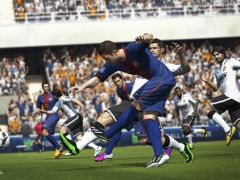Video Gamer is reader-supported. When you buy through links on our site, we may earn an affiliate commission. Prices subject to change. Learn more
Variety of Passing
/https://oimg.videogamer.com/images/1272/fifa_1411.jpg)
Soon after FIFA 14 arrived on current-gen consoles, people realised that through balls and headers were overpowered. EA addressed this with a patch, but the underlying problems with passing are likely to remain. Due to the limitations of the hardware, there is only one player animation for short passes. Have a look the next time you play a match: the body posture for most passes is the same. This means that the spin and flight of the ball has often remained unchanged, too.
With the next-gen consoles, EA has been able to add a bunch of new ways for players to connect with the ball. Through balls with the outside of the foot, cushioned touches to close team-mates, and flat long passes are all possible thanks to the greater variety in how you can approach the ball. The different spin on the ball means that the same pass can always play out in a new manner, affecting the outcome of attacks. Players will have a harder time finding techniques to exploit due to the more realistic unpredictability of passing.
Contextual factors now feel like they play a bigger role: pressure on the man in possession, direction of movement compared to the direction of the intended pass, power, and so on, all must be taken into consideration when breaking down defences.
In my time with the game, I misplaced, under- and over-hit passes and never once found myself frustrated because of the core mechanics. I wasn’t being let down by flawed design, but the dynamic nature of human error. A player’s inability to execute what I envisioned, or my own failure to apply the right power or placement, were the reasons for failed passes.
You have to work harder to earn opportunities, creating a much greater sense of satisfaction when the ball finally hits the back of the net.
Improved Heading
This variety also extends to headers. More than two players are now able to compete in aerial challenges, making corners far more interesting.
You’re going to have to improve your positioning skills quickly, as it’s also much easier to mistime headers. There were times the ball was cleared to the half-way line, and I left a centre-back stranded after spamming the B button only for him to jump aimlessly and stumble yards away from the action.
Players are also more difficult to knock off the ball, too. The momentum system has been taken to the next level with what EA refers to as “True Player Motion” and you will find it more difficult to win possession with standing and slide tackles alone. The positioning of a defenders body is now a major factor as players can win back the ball without committing to a challenge and risking a foul. Simply moving your body in between man and ball is enough.
Hopefully the bizarre refereeing decisions as a result of delayed collisions that fill endless YouTube compilations will be a thing of the past as well.
The Camera
The standard camera on next-gen is lower in order to place more emphasis on the crowd. Not only does this help you see some of the cool new features on the sidelines (players exiting the dugout to warm up, better looking fans and ball boys running to collect the ball), this new view also makes it easier to see across the width of the pitch. Switching the play becomes easier, as you are no longer reliant on the map to judge spacing between your men and defenders.
This lower camera also gives a much nicer view of the action, and doesn’t noticeably affect how much of the length of the pitch you can see compared to the higher ‘tele’ or ‘broadcast’.
Replays
Replays are no longer exclusively for goals. The game will now bring attention to other highlights, including skill moves and good saves. While the ball is out of play, the camera will zoom in on a player who is the focus of an upcoming replay, which could have occurred much earlier in the match. Whereas current-gen only uses replays immediately following key moments, next-gen FIFA will refer back throughout the course of play.
EA has also replicated every camera angle used in real stadiums. Cuts to players are also deliberately off-centre in order to replicate the the frenetic attempts of cameramen to keep up with the action.
No Cut-scenes
Everything that occurs within a match in next-gen FIFA 14 occurs in real-time. Whenever the ball goes out of play, there is nothing that needs to be skipped (though it can be, if you choose), goalkeepers will run to collect the ball for goal-kicks, players will wait for ball boys to retrieve the ball for a throw-in, and the referee will look to the fourth official as he walks out from the dug-out with the substitution board.
Gone are the load-times and repetitive cut-scenes of players walking around having fake conversations or jogging up the pitch before being substituted. Now there isn’t a moment where you are taken out of the action in order for the game to load the changes.
Want to know more about current-gen FIFA? Read our review by clicking here.

/https://oimg.videogamer.com/images/6bf5/fifa_14_1-121813.jpg)
/https://oimg.videogamer.com/images/d900/fifa_14_34.jpg)
/https://oimg.videogamer.com/images/bd6c/fifa_14_2-121814.jpg)
/https://oimg.videogamer.com/images/9294/fifa_14_31.jpg)